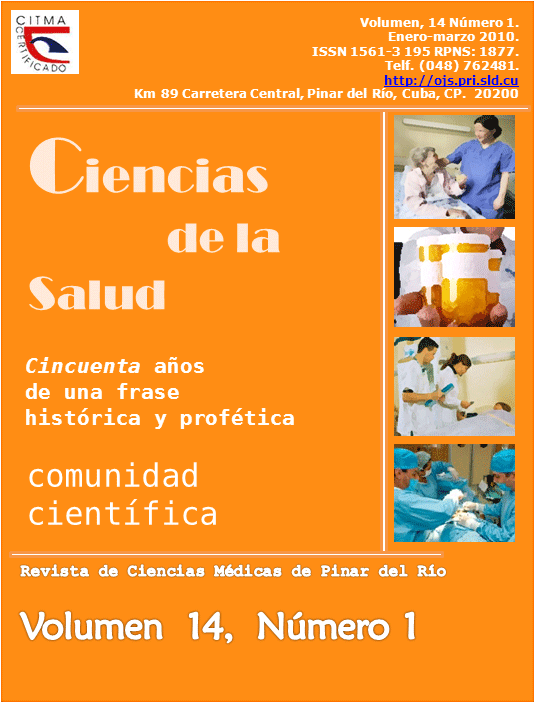Tuberculosis and pediatric AIDS: a case report in Mozambique
Abstract
Tuberculosis (abbreviated TB for tubercle bacillus or Tuberculosis), is a disease caused by Mycobacterium Tuberculosis Hominis, weakly Gram-positive bacillus, aerobic, acid-alcohol resistance, of curved aspect, motionless and sporeless. TB constitutes one of the re-emergent diseases in the childhood all over the world. Acquired Immunodeficiency Syndrome (AIDS) is the most important risk factor to the TB development. Despite the incidence of both diseases is low in relation to the worldwide statistics; and according to the World Health Organization (WHO), the states and sanitary authorities are making a great effort to carry out an effective control and an adequate management of the cases recorded. Encouraged by the presence of the Cuban Medical Internationalist Missions in several countries the case is presented in order to transmit experience. A 4-year-old, black boy, coming from a rural region in Mampula City, Mozambique, sub-Saharan Africa; the clinical and laboratory findings confirmed a pulmonary TB, also the presence of AIDS was verified (positive HIV and lymphocytes CD4+ in 15%). An adequate therapeutic taking into account the protocols established in Mozambique for both diseases was followed with the purpose of improving the clinical conditions of the patient, which made possible changes in the quality of life and life expectancy.Downloads
References
1. Lienhardt C, Rodriguez L C. Estimation of the impact the human immunodeficiency virus infection on tuberculosis: tuberculosis risks revisited Int J Tuberc Lung Dis. 1998; 1(3): 196-204.
2. Raviglione MC; Harries AD, Msiska R, Wilkinson D, Nunn P. Tuberculosis and HIV: current status in Africa. AIDS.1997; 11(suppl B): 115-S123.
3. Raviglione MC; Harries AD, Msiska R: Tuberculosis and HIV current status in Mozambique; 2007.
4. Daley CL.: Current status in Africa Tuberculosis recurrence in Africa: true relapse or re-infection Lancet .2004; 342:756-57.
5. Bleed D, Dye C, Raviglione M: Dynamics and control of the global tuberculosis epidemy. Current Opinion in Pulmonary Medicine .2006:174 -179.
6. Colectivo de Autores: Conociendo sobre VIH, Centro Nacional de ITS / VIH / SIDA, La Habana; 2004.
7. Friedland GH; Andrews L A.: Adherence to Antiretroviral Therapy. AIDS Rev; 2001:3:111-20.
8. Barreto M. Impacto demográfico do HIV/SIDA em Moçambique (Actualizaçâo), Rev. Nac. Pediatría, vol. 18, supl.1: 53-57. año 2006.
9. Ministério da Saúde do Brasil, guia de tratamento clínico da infecção pelo HIV em criança; 2003.
10. Pediatric Human Immunodeficiency virus (HIV), infection, guidelines of pediatric HIV infection, American Academy of Pediatrics; 2003.
11. Roberts MC, Wallander JL. Family Issues in Pediatric Psychology. Hillsdale, NJ Publication Year [citado], 1992. Disponible en: http://www.questia.com/library/book/family-issues-in-pediatric-psychology-by-michael-c-roberts-jan-l-wallander.jsp
12. Chile. Ministerio de Salud. Guía Clínica Síndrome de la Inmunodeficiencia Adquirida. VIH/SIDA.1st Ed. Santiago: Minsal [Serie en Internet], 2005[Consultado el 11 noviembre 2009] Disponible en: http://www.redsalud.gov.cl/archivos/guiasges/vihsidaR_Mayo10.pdf
Published
How to Cite
Issue
Section
License
Authors who have publications with this journal agree to the following terms: Authors will retain their copyrights and grant the journal the right of first publication of their work, which will be publication of their work, which will be simultaneously subject to the Creative Commons Attribution License (CC-BY-NC 4.0) that allows third parties to share the work as long as its author and first publication in this journal are indicated.
Authors may adopt other non-exclusive license agreements for distribution of the published version of the work (e.g.: deposit it in an institutional telematic archive or publish it in a volume). Likewise, and according to the recommendations of the Medical Sciences Editorial (ECIMED), authors must declare in each article their contribution according to the CRediT taxonomy (contributor roles). This taxonomy includes 14 roles, which can be used to represent the tasks typically performed by contributors in scientific academic production. It should be consulted in monograph) whenever initial publication in this journal is indicated. Authors are allowed and encouraged to disseminate their work through the Internet (e.g., in institutional telematic archives or on their web page) before and during the submission process, which may produce interesting exchanges and increase citations of the published work. (See The effect of open access). https://casrai.org/credit/



